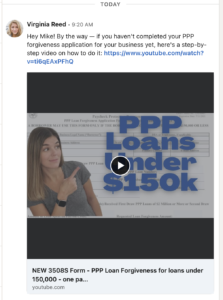Nothing is more exciting for us than to notify our clients about their first set of leads. People are interested in their product or service, and there’s potential to close a sale.
But it’s not as easy as hopping on the phone and signing a contract. without a good infrastructure for nurturing these leads. The average B2B buying cycle is 6-12 months long, and it takes 7-13 touchpoints for the average buyer to have enough information to take the next step.
Once your pipeline is full of great prospects, the next step is to continue following up and building a relationship with those people.
Tips for nurturing:
- Lead with value
- Use a multi-channel approach
- Follow-up, follow-up, follow-up!
Every company, offer, and prospect is different, and the number one best way to connect with them is to base your sales strategy on their unique situations. In order to take a personalized sales approach, you’ll need to have an introductory conversation to learn your prospect’s unique needs.
The great news is that you can build these touchpoints into your prospecting approach to facilitate, and accelerate, the process.

These can happen via email, LinkedIn, phone, in-person, or otherwise. And it’s best to mix up your types of follow-ups.
For example, some people respond better to video. Others are interested in case studies. And some people love being active in LinkedIn Groups.
Don’t forget to drop the occasional call-to-action (or tripwire, see below!) in there. The key word here is occasional—too many requests can feel pushy and overwhelming. Prospect nurturing is more about building the relationship and the best way to initiate that is by giving value to your contacts.
Here are a few of the most effective ways to engage your prospects and move them down your pipeline:
1. Share news from your industry
If you’re an expert in your field, and have your finger on the pulse in the industry, there’s likely a lot of news that your prospects could benefit from knowing about. The biggest hurdle in any sales and marketing effort is awareness.
Everyone likes to stay up to date… So hand-select a couple of pieces of industry news that your prospect needs to know, and then share the information with them.
Hey John, Spotify just published some crazy numbers on the fastest podcast categories. I know you’re in PR, so I figured you’d be interested to see! Here’s the link: ….
When your intention is to share and warm-up, leave off the call to action. . Just focus on the share and giving value. That’s how relationships work 🙂
2. Share a video
YouTube video links will often populate thumbnail images in most chats on LinkedIn, Facebook, or even email threads.
This is useful because the thumbnail and title can help to draw the prospect’s interest to watch it. (Hint: use an appealing title and thumbnail!) Plus, they can hit play and watch it right there on the platform. That greatly increases watch time versus when someone has to click off to another page.
In our visual, online world, many people will watch a video instead of reading a few paragraphs of text.

3. Share a case study for their industry
People always want to know what other successful companies in their space are doing (or other successful leaders in their role, if they’re not an executive)… especially if it’s working.
So, if you’ve completed a successful project for another company in your prospects industry, it’s pretty likely that they’d be interested in hearing about it.
This one is all about building trust. Show your stuff!
Sarah, we just launched a new UI/UX interface for a top-rated iOS app. The last version won an Apple Design award, but we added a new twist this year. I’m just sharing with others in app development in my network to start 🙂 Anyways, here’s the link: […] I’d love to hear your thoughts!
4. Invite to a group
Do you have a group on LinkedIn or Facebook? If not, you should! Groups are an effective way to stay connected with your prospects. It’s just another channel to stay in touch on a platform they’re already on.
People who are in your groups (and who are connected or friends with you) see your posts and activity much more frequently than just being connected with them.
Just invite them to the group or shoot them a message letting them know there are some great conversations happening with others in their industry! (#FOMO)

5. Invite to an event
You’ve probably seen a few LinkedIn Events popping up recently. They’re a new feature that they rolled out this past year, and since it’s a new feature that LinkedIn is looking to promote, the algorithm is giving these events a boost.
That makes now a great time for creating a LinkedIn Event for any webinars, events, etc. that you have coming up. Get some free organic reach out of that!

6. Offer a newsletter
We mentioned it earlier: people want to stay up to date as to what’s happening in their industry, their city, and their profession.
If you publish a regular newsletter (and you should), then try briefly describing the content and asking your prospect if they’d like to subscribe..
Note, we’re not talking about a generic company newsletter with updates about your company. That will do more harm than good, as your prospects will begin to associate you with annoying unread emails.
Instead, if you publish a monthly report on “New Startup Funding in Colorado” or “July’s Must Attend Virtual Events for HR Professionals”, then your prospects will actually want to engage with the content and learn from it.
7. Offer a tripwire
As we edge towards the bottom of the list, our tactics are getting more direct—as they should! As you build up a relationship with people in your industry, you’ll learn about them, their challenges, and what they’re working on.
At that point, it would be an oversight not to offer your help.
But going straight for the sale usually doesn’t work. Instead, use a tripwire.
Offer them something that’s low commitment and free (or very cheap, but we prefer free for the first stage). Think of a free assessment, or offering them a second opinion.
Some examples are:
- Free cyber security assessment.
- Second opinion on your current energy expenditures.
- SEO scan of their home page.
8. Offer a call
If your goal is to get on the phone with prospects, eventually you have to ask for a call.
When you do, be direct and clear, but don’t be overbearing or robotic. If people feel pressured, they just won’t respond.
Instead, make it conversational, and let them know what they’ll get by showing up to the call.
- “Hey John, I saw you downloaded our 2021 report and I wanted to reach out. The next step most people take is signing up for a free strategy call. We’ve helped over 100 financial advisors this month alone. How about next week?”
- “Good question – I just walked someone else through that on a Zoom call. How about we grab a time for next week?”
- “Want to see how much this can speed up your system? Just let me know when you have 15 min free to chat”
- “Hey Meghan, we connected a few months ago and I remembered you’re in the legal space, so I had to double-back. We’ve built websites for 10+ law firms this month and I thought you may be interested to see a few examples. Are you free for a call next week?”
Pro tip: Speedwork offers a call service as an add-on to our LinkedIn Messaging Campaigns!
Lead nurturing takes time, effort, and patience but if it’s done correctly, it almost always results in a meaningful connection, if not a new customer. If you’re handling lead nurturing along with typical day-to-day executive tasks, it may be best to carve out an hour per day to devote to ongoing conversations with prospects. If that’s too overwhelming, try delegating the tasks to an assistant or business development manager.
Remember that rejections, objections, and brush-offs are a given, and they don’t always actually mean the prospect can’t use your services. Companies tend to focus on different priorities month to month and quarter to quarter, and they may not be focused in the area of your product or service at the moment. Give them some time to cool off, and try touching base again later.
Lastly, know when to let things lie. If at any point during your conversation with a prospect you notice that they wouldn’t make a good fit, simply signoff in a friendly manner and move on. There are plenty of other fish in the sea!
Good luck, and stay confident!
